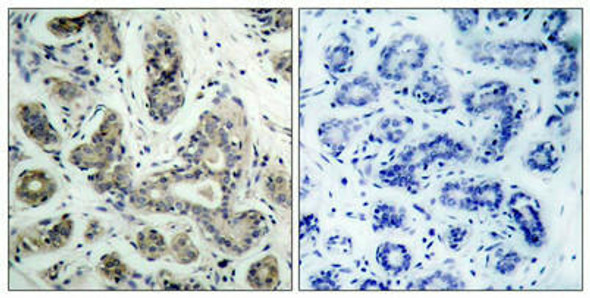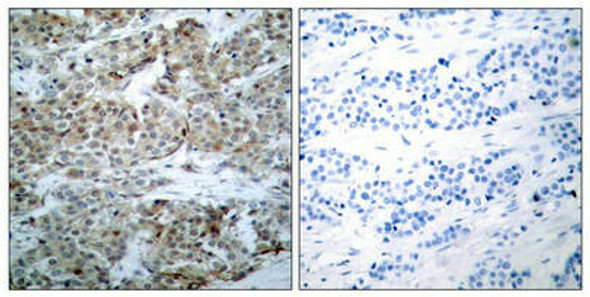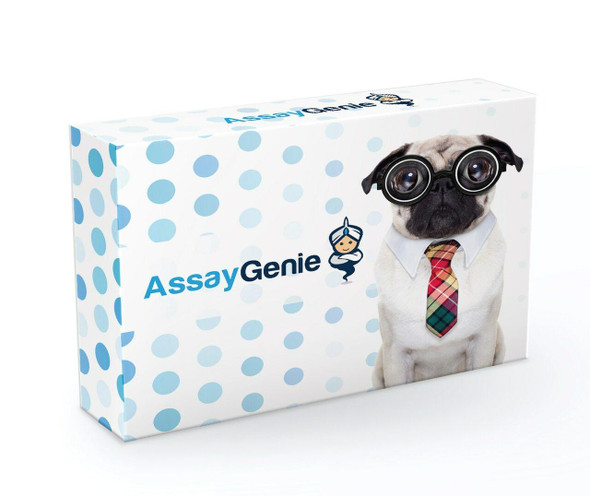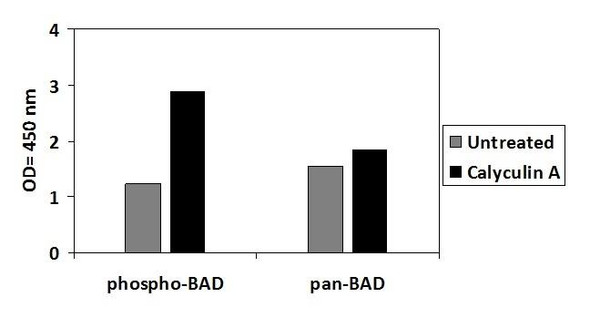Phospho-Bad (Ser155) Antibody (PACO24359)
- SKU:
- PACO24359
- Product Type:
- Antibody
- Reactivity:
- Human
- Mouse
- Rat
- Host Species:
- Rabbit
- Isotype:
- IgG
- Applications:
- ELISA
- WB
- IHC
- Antibody Type:
- Polyclonal Antibody
- Conjugation:
- Unconjugated
Description
Phospho-Bad (Ser155) Antibody (PACO24359)
The Phospho-BAD (Ser155) Antibody (PAC024359) is a highly specific tool for researchers studying the BAD protein, a key regulator of cell survival and apoptosis. This antibody, raised in rabbits, is designed for use in various applications including Western blotting and immunohistochemistry, with high specificity for human samples.BAD, a member of the Bcl-2 family of proteins, plays a crucial role in regulating cell death by promoting apoptosis. Phosphorylation of BAD at Serine 155 has been shown to inhibit its pro-apoptotic activity, making this phosphorylation site a key target for studies on cell survival and death pathways. The Phospho-BAD (Ser155) Antibody enables researchers to detect and analyze this specific phosphorylation event in various cell types, providing valuable insights into the mechanisms of cell fate determination.
The significance of BAD in cell survival and apoptosis makes it a promising target for research into cancer, neurodegenerative diseases, and other conditions characterized by dysregulated cell death pathways. By studying the phosphorylation state of BAD at Serine 155, researchers can gain a deeper understanding of the molecular mechanisms underlying these diseases, paving the way for the development of targeted therapies.
| Antibody Name: | Phospho-Bad (Ser155) Antibody (PACO24359) |
| Antibody SKU: | PACO24359 |
| Size: | 100ul |
| Host Species: | Rabbit |
| Tested Applications: | ELISA, WB, IHC |
| Recommended Dilutions: | ELISA:1:2000-1:10000, WB:1:500-1:1000, IHC:1:50-1:100 |
| Species Reactivity: | Human, Mouse, Rat |
| Immunogen: | Peptide sequence around phosphorylation site of serine 155(R-M-S(p)-D-E) derived from Human BAD. |
| Form: | Liquid |
| Storage Buffer: | Supplied at 1.0mg/mL in phosphate buffered saline (without Mg2+ and Ca2+), pH 7.4, 150mM NaCl, 0.02% sodium azide and 50% glycerol. |
| Purification Method: | Antibodies were produced by immunizing rabbits with synthetic phosphopeptide and KLH conjugates. Antibodies were purified by affinity-chromatography using epitope-specific phosphopeptide. Non-phospho specific antibodies were removed by chromatogramphy using non-phosphopeptide. |
| Clonality: | Polyclonal |
| Isotype: | IgG |
| Conjugate: | Non-conjugated |
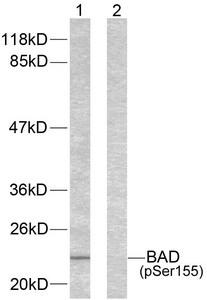 | Western blot analysis of extracts from 293 cells using BAD (phospho-Ser155) antibody. |
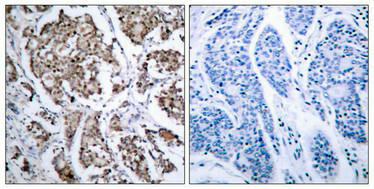 | Immunohistochemical analysis of paraffin-embedded human breast carcinoma tissue using BAD (phospho- Ser155) antibody. |
| Background: | Promotes cell death. Successfully competes for the binding to Bcl-X(L), Bcl-2 and Bcl-W, thereby affecting the level of heterodimerization of these proteins with BAX. Can reverse the death repressor activity of Bcl-X(L), but not that of Bcl-2. Appears to act as a link between growth factor receptor signaling and the apoptotic pathways. Schurmann A., Mooney A.F., Sanders L.C., Sells M.A., Wang H.G., Reed J.C., Bokoch G.M.Mol. Cell. Biol. 20:453-461(2000) Jakobi R., Moertl E., Koeppel M.A.J. Biol. Chem. 276:16624-16634(2001) |
| Synonyms: | Bbc2; AI325008 |
| UniProt Protein Function: | BAD: a proapoptotic member of the Bcl-2 family. Displaces Bax from binding to Bcl-2 and Bcl-xL, resulting in cell death. Survival factors such as IL-3 can inhibit the apoptotic activity of Bad inducing the phosphorylation of Bad by Akt and p90RSK. 14-3-3 proteins bind phosphorylated Bad, inhibiting its binding to Bcl-2 and Bcl-xL. Phosphorylation by mitochondria-anchored PKA in the BH3 domain can block the dimerization of Bad and Bcl-xL. |
| UniProt Protein Details: | Protein type:Apoptosis Cellular Component: mitochondrial outer membrane; mitochondrion; membrane; cytoplasm; intracellular; cytosol Molecular Function:protein kinase B binding; protein binding; protein heterodimerization activity; phospholipid binding; caspase activator activity; protein kinase binding; lipid binding; protein phosphatase binding; protein phosphatase 2B binding Biological Process: positive regulation of proteolysis; apoptosis; positive regulation of apoptosis; positive regulation of caspase activity; regulation of caspase activity; cellular process regulating host cell cycle in response to virus; glucose homeostasis; positive regulation of apoptosis by virus; regulation of apoptosis; pore complex biogenesis; positive regulation of glucokinase activity; caspase activation; release of cytochrome c from mitochondria; cytokine and chemokine mediated signaling pathway; suppression by virus of host apoptosis; ADP metabolic process; positive regulation of insulin secretion; ATP metabolic process; glucose catabolic process; cell proliferation; positive regulation of T cell differentiation; induction of apoptosis via death domain receptors; DNA damage response, signal transduction resulting in induction of apoptosis; positive regulation of B cell differentiation; regulation of mitochondrial membrane permeability; positive regulation of epithelial cell proliferation |
| UniProt Code: | Q61337 |
| NCBI GenInfo Identifier: | 2493288 |
| NCBI Gene ID: | 12015 |
| NCBI Accession: | Q61337.1 |
| UniProt Related Accession: | Q61337 |
| Molecular Weight: | |
| NCBI Full Name: | Bcl2-associated agonist of cell death |
| NCBI Synonym Full Names: | BCL2-associated agonist of cell death |
| NCBI Official Symbol: | Bad |
| NCBI Official Synonym Symbols: | Bbc2; AI325008 |
| NCBI Protein Information: | bcl2-associated agonist of cell death; bcl-2-binding component 6; bcl2 antagonist of cell death; bcl-xL/Bcl-2-associated death promoter |
| UniProt Protein Name: | Bcl2-associated agonist of cell death |
| UniProt Synonym Protein Names: | Bcl-2-binding component 6; Bcl-xL/Bcl-2-associated death promoter; Bcl2 antagonist of cell death |
| Protein Family: | Bcl2-associated agonist of cell death |
| UniProt Gene Name: | Bad |
| UniProt Entry Name: | BAD_MOUSE |








